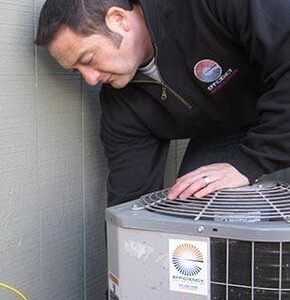A room without windows can quickly feel stuffy, humid, or stale, especially in Portland’s changing climate. Without natural airflow, fresh air circulation becomes challenging. But with the right strategies, you can keep these enclosed spaces fresh, calm, and breathable.
Use a Ventilation Fan
A high-quality ventilation fan pulls out stagnant air and replaces it with fresh, clean air. You can install it on the ceiling or the wall. It’s one of the most effective ways to circulate air where no windows are available. If your room already has poor airflow or the indoor fan keeps running, this upgrade helps restore balance.
Keep Doors Open Whenever Possible
Keeping the door open allows cross-ventilation with the rest of your home. It reduces heat and humidity buildup, helping your HVAC system circulate conditioned air more effectively. If your HVAC system isn’t reaching that room, check for inconsistent temperatures throughout the house.
Try an Air Purifier with a Fan
Air purifiers with built-in fans do double duty—cleaning the air while circulating it. They improve indoor air quality by removing dust, allergens, and odors while promoting airflow in enclosed spaces.
Install a Ductless Mini-Split
If the room isn’t connected to your central HVAC system, a ductless mini-split is a game-changer. It offers independent temperature control and consistent airflow, eliminating the need for windows or ductwork.
Install a Ceiling Fan with Reverse Mode
A ceiling fan that supports reverse spin helps push warm air down in winter and pull cooler air up in summer. This keeps the room’s temperature balanced even without natural airflow.
Use a Portable Air Conditioner with Venting
Portable ACs with hose venting systems can effectively cool enclosed rooms. Vent them through a nearby door or wall. Some models include dual-hose systems for improved circulation.
Clean or Replace HVAC Filters Regularly
Clogged filters restrict airflow, particularly in rooms that are already struggling with ventilation. Replacing them every 1–3 months supports better overall circulation and air quality.
Position Furniture to Allow Flow
Avoid placing beds or couches directly in front of vents. Keep a clear path for air movement. This small change can have a significant impact in sealed spaces.
Add a Door Vent or Undercut the Door
Installing a door grille or leaving a small gap at the bottom of the door (undercutting) allows air to flow freely between the room and adjacent spaces, even when the door is closed.
Use an Exhaust Fan in the Adjacent Room.
If the closed room is next to a bathroom or utility space with an exhaust fan, running that fan pulls stale air out and draws fresher air into the windowless room.
Check for Insulation and Seal Gaps
Air leaks or poor insulation can trap heat, making the room feel even more stagnant. Sealing cracks and insulating the space helps your circulation devices work more effectively.
Schedule a Professional HVAC Inspection
If airflow remains poor, it’s time to bring in a professional. An inspection can reveal whether the HVAC system is too old or if there’s a need for duct adjustments, fan upgrades, or system zoning.
Use a Floor Fan Strategically
Place a fan near the door or hallway to pull in air from the rest of the house. Oscillating fans are most effective at evenly distributing airflow throughout the space. If you hear unusual sounds while running your system, you may also want to check if your HVAC system is making a whistling noise.
Run Your HVAC Fan Continuously
Set your HVAC system to “fan on” mode instead of “auto.” This helps move air into the room, even when the system isn’t actively heating or cooling. It’s beneficial in closed-off areas.
Consider Transfer Grilles or Jump Ducts
These are installed in walls or ceilings and connect rooms for better airflow. They work well when you want to keep doors closed for privacy, but still need air movement.
Don’t Block Return Air Vents
If you have return air vents in the room, keep them clear of furniture or curtains. Blocked vents reduce airflow, causing uneven cooling. This can result in stale air and high humidity. If unsure, check for issues like an HVAC unit that doesn’t turn off at the set temperature.
Monitor Humidity Levels
Use a dehumidifier if the room feels damp. Moisture buildup is a common issue in non-ventilated spaces, which can lead to the growth of mold or mildew. Dehumidifiers also support easier airflow.
Read More:
- The indoor fan keeps running
- Inconsistent temperatures throughout the house
- Ductless mini-splits sizing
- HVAC system makes a whistling noise
- Carrier – Ventilation in Homes Without Windows
FAQs
Why does my windowless room feel stuffy?
Lack of ventilation traps air and humidity, causing stuffiness and poor air quality.
What’s the best fan setup for a room without windows?
A combination of a ceiling or ventilation fan plus an air purifier works best.
Can I use a ductless AC for this room?
Yes, mini-splits are perfect for rooms without existing ductwork or windows.
Does leaving the door open help?
Yes, it allows airflow from the rest of your home and your HVAC system to enter.
How often should I run the HVAC fan?
Running it continuously or at regular intervals improves air circulation.
Will a dehumidifier help with air quality?
Yes, it reduces moisture, which helps prevent mold and improves airflow.
What if I still feel no airflow?
Check for blocked vents, poor HVAC settings, or consider adding return ducts to improve airflow.
Do air purifiers help with airflow?
They clean and move air, which benefits rooms with no natural ventilation.
Can smart thermostats detect airflow issues?
They can signal hot spots or temperature inconsistencies, but they don’t fix airflow issues.
Is professional ductwork modification needed?
If basic solutions fail, yes—experts may recommend duct additions or fans.



